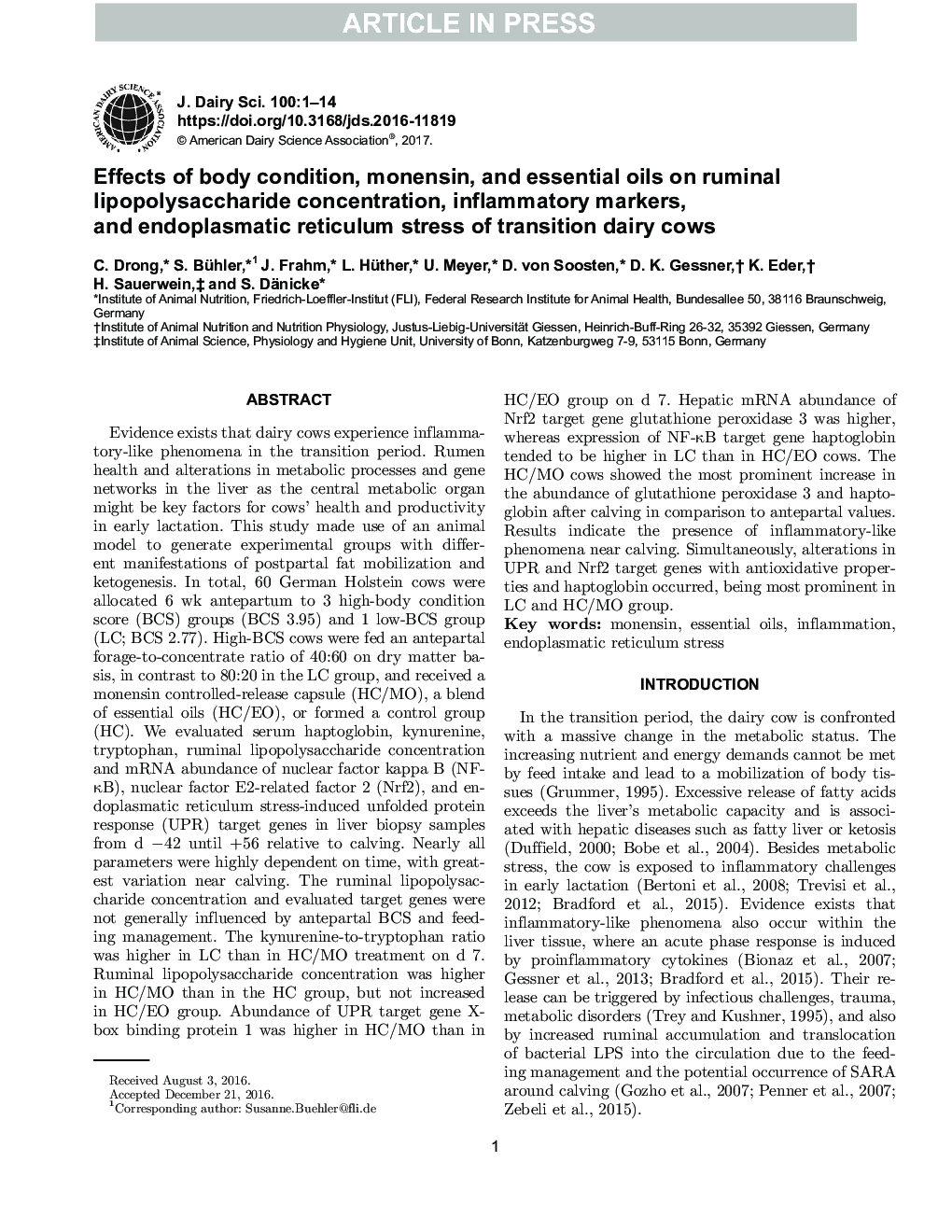| کد مقاله | کد نشریه | سال انتشار | مقاله انگلیسی | نسخه تمام متن |
|---|---|---|---|---|
| 5542333 | 1402517 | 2017 | 14 صفحه PDF | دانلود رایگان |
عنوان انگلیسی مقاله ISI
Effects of body condition, monensin, and essential oils on ruminal lipopolysaccharide concentration, inflammatory markers, and endoplasmatic reticulum stress of transition dairy cows
ترجمه فارسی عنوان
تأثیر شرایط بدن، موننسین و اسانس های ضروری بر میزان غلظت لیپوپلی ساکارید شفاف، نشانگرهای التهابی و استرس انوپلاستمائی در گاوهای شیرده
دانلود مقاله + سفارش ترجمه
دانلود مقاله ISI انگلیسی
رایگان برای ایرانیان
کلمات کلیدی
موننسین، روغن ضروری، التهاب استرس تناسلی اندوپلاسمی،
موضوعات مرتبط
علوم زیستی و بیوفناوری
علوم کشاورزی و بیولوژیک
علوم دامی و جانورشناسی
چکیده انگلیسی
Evidence exists that dairy cows experience inflammatory-like phenomena in the transition period. Rumen health and alterations in metabolic processes and gene networks in the liver as the central metabolic organ might be key factors for cows' health and productivity in early lactation. This study made use of an animal model to generate experimental groups with different manifestations of postpartal fat mobilization and ketogenesis. In total, 60 German Holstein cows were allocated 6 wk antepartum to 3 high-body condition score (BCS) groups (BCS 3.95) and 1 low-BCS group (LC; BCS 2.77). High-BCS cows were fed an antepartal forage-to-concentrate ratio of 40:60 on dry matter basis, in contrast to 80:20 in the LC group, and received a monensin controlled-release capsule (HC/MO), a blend of essential oils (HC/EO), or formed a control group (HC). We evaluated serum haptoglobin, kynurenine, tryptophan, ruminal lipopolysaccharide concentration and mRNA abundance of nuclear factor kappa B (NF-κB), nuclear factor E2-related factor 2 (Nrf2), and endoplasmatic reticulum stress-induced unfolded protein response (UPR) target genes in liver biopsy samples from d â42 until +56 relative to calving. Nearly all parameters were highly dependent on time, with greatest variation near calving. The ruminal lipopolysaccharide concentration and evaluated target genes were not generally influenced by antepartal BCS and feeding management. The kynurenine-to-tryptophan ratio was higher in LC than in HC/MO treatment on d 7. Ruminal lipopolysaccharide concentration was higher in HC/MO than in the HC group, but not increased in HC/EO group. Abundance of UPR target gene X-box binding protein 1 was higher in HC/MO than in HC/EO group on d 7. Hepatic mRNA abundance of Nrf2 target gene glutathione peroxidase 3 was higher, whereas expression of NF-κB target gene haptoglobin tended to be higher in LC than in HC/EO cows. The HC/MO cows showed the most prominent increase in the abundance of glutathione peroxidase 3 and haptoglobin after calving in comparison to antepartal values. Results indicate the presence of inflammatory-like phenomena near calving. Simultaneously, alterations in UPR and Nrf2 target genes with antioxidative properties and haptoglobin occurred, being most prominent in LC and HC/MO group.
ناشر
Database: Elsevier - ScienceDirect (ساینس دایرکت)
Journal: Journal of Dairy Science - Volume 100, Issue 4, April 2017, Pages 2751-2764
Journal: Journal of Dairy Science - Volume 100, Issue 4, April 2017, Pages 2751-2764
نویسندگان
C. Drong, S. Bühler, J. Frahm, L. Hüther, U. Meyer, D. von Soosten, D.K. Gessner, K. Eder, H. Sauerwein, S. Dänicke,
